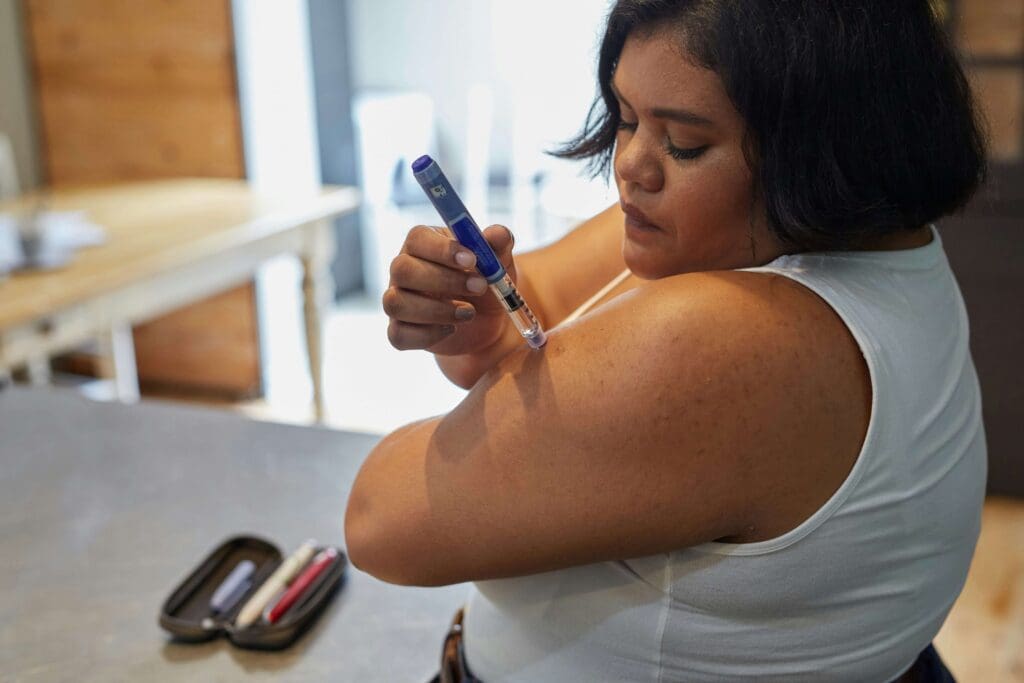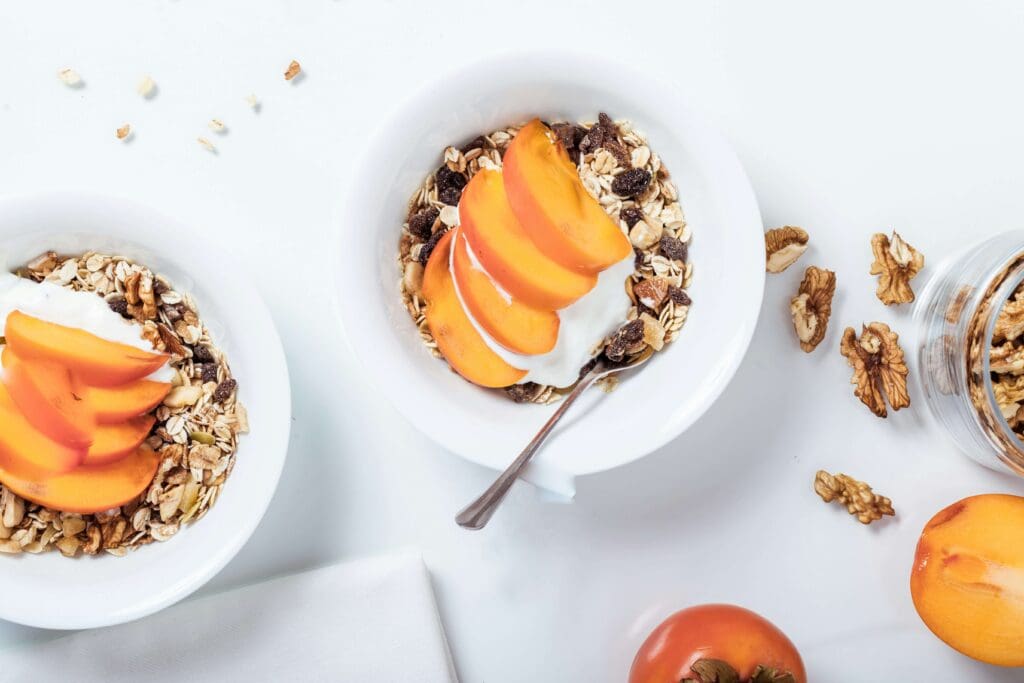Introduction
As an oncology dietitian, I frequently work with individuals who have multiple chronic illnesses. A common combination I often see is diabetes and cancer. In fact, approximately 8-18% of those with cancer have diabetes. The relationship between diabetes and cancer risk is complex. Diabetes may contribute to an increased risk of certain types of cancer, and those with diabetes may have to take extra care to manage both conditions.
What is Diabetes

Diabetes is a metabolic disorder where either the pancreas stops producing insulin (the hormone that allows sugar to enter our cells for energy) or the cells become insulin resistant. In both cases, sugar builds up in the blood and, at high sustained levels, it can cause damage to virtually every body system.
How Can Diabetes Affect Cancer Risk?
- Hyperinsulinemia: In Type 2 Diabetes, the pancreas produces more insulin, leading to elevated insulin levels in the bloodstream. This may promote cancer cell growth.
- Chronic Inflammation: Diabetes is characterized by chronic low-grade inflammation, which may contribute to the development and progression of cancer.
- Obesity: Obesity is a significant risk factor for both type 2 diabetes and certain types of cancer. Excess body fat, especially around the abdomen, contributes to insulin resistance, inflammation, and dysregulation of hormone levels associated with cancer development.
- Hyperglycemia: Persistent high blood sugar levels seen in some cases of diabetes may promote oxidative stress and DNA damage.
- Shared Risk Factors and Comorbidities: Diabetes shares several risk factors and comorbidities with cancer, such as aging, unhealthy diet, physical inactivity, and smoking. These shared factors may contribute independently or synergistically to increased cancer risk among individuals with diabetes.
- Specific Cancer Types: Diabetes has been consistently associated with an increased risk of certain types of cancer, including colorectal cancer, pancreatic cancer, liver cancer, breast cancer (postmenopausal women), endometrial cancer, and bladder cancer. The strength of the association may vary depending on factors such as diabetes duration, glycemic control, obesity status, and other confounding variables.
It’s important to note that while diabetes is associated with an increased risk of certain cancers, having diabetes does not necessarily mean a person will develop cancer. However, managing diabetes through lifestyle modifications (e.g., healthy diet, regular exercise, weight management) and appropriate medical care (e.g., blood sugar control, medication adherence) is essential for reducing the risk of complications, including cancer, and improving overall health outcomes.
8 Steps for Those With Cancer and Diabetes
What if you are juggling both conditions? Managing diabetes while preparing for cancer treatment involves careful coordination between healthcare providers and a comprehensive plan to maintain blood sugar levels while addressing cancer. Here are key steps to prepare:
1. Consult with Healthcare Providers

Have regular appointments with both your oncology and diabetes care team to monitor progress and make necessary adjustments. You may also want to work with a dietitian to create a meal plan that supports both cancer treatment and blood sugar control.
2. Medical Assessments and Adjustments
Prior to treatment, get baseline readings of your blood sugar levels, HbA1c, kidney function, and other relevant parameters. Some cancer treatments and/or treatment side effects can alter blood sugar levels, requiring dose adjustments. Chemotherapy and steroid medications for example can cause high blood sugar. High blood sugar levels during surgery can impair how well wounds heal. Nausea and vomiting or a poor appetite can lead to low blood sugar.
4. Diet and Nutrition
Proper nutrition is paramount for optimal management of both conditions. The following can ensure you are providing your body with the best tools possible to thrive during treatment.

Balanced Diet: Maintain a diet high in nutrients but be mindful of carbohydrate intake to keep blood sugar stable.
Small, Frequent Meals: Eating smaller, more frequent meals can help manage blood sugar levels and reduce nausea.
Hydration: Stay well-hydrated, as dehydration can affect blood sugar levels and how well you recover after treatments.
Balanced Carbohydrates: Choose fiber-rich vegetables and whole grains that provide essential nutrients without causing blood sugar spikes.
Protein Choices: Include a variety of proteins that are easy to digest and support both diabetes management and muscle maintenance during cancer treatment.
Healthy Fats: Use sources that provide energy and essential fatty acids without negatively impacting blood sugar levels.
Hydration and Caloric Density: Incorporate smoothies, meal replacement drinks, and soups that are nutrient-dense and help maintain hydration and caloric intake. Make sure the beverages are not high in sugar unless you are treating low blood sugar.
Side Effect Management: Keep a variety of foods on hand to adjust for side effects such as nausea, vomiting, or mouth sores. Bland, easy-to-digest foods can help during difficult times.
5. Physical Activity

Before starting a physical activity regimen, get clearance from your healthcare providers about the type and amount of exercise safe during treatment. Adjust the intensity and duration according to energy levels and treatment side effects.
6. Monitoring and Managing Side Effects
Side Effect Management: Be aware that treatments like chemotherapy and radiation can cause nausea, vomiting, and loss of appetite, impacting blood sugar control.
Dehydration – Those with diabetes may be at a greater risk for dehydration during cancer treatment since high blood sugar levels can cause one with diabetes to urinate more frequently. Poor hydration and high blood sugar levels can also slow recovery after treatment.
Medication for Side Effects: Use prescribed medications to manage side effects, which can indirectly help maintain stable blood sugar levels.
7. Stress Management
Stress Reduction Techniques: Use relaxation techniques like deep breathing, meditation, or yoga, as stress can affect blood sugar levels.
Support System: Engage with support groups, friends, and family for emotional support during treatment.
8. Have an Emergency Plan
Have a plan in place for managing low or high blood sugar episodes. Keep emergency snacks and medications on hand. Make sure you have a list of emergency contacts, including healthcare providers, readily available.
Practical Tips
Meal Prep and Planning: Prepare meals in advance to ensure availability of healthy options, especially when energy levels are low.
Food Safety: Pay extra attention to food safety to avoid infections, especially during cancer treatment when the immune system may be compromised.
Monitor Blood Sugar: Regularly monitor blood glucose levels and adjust the diet as needed, based on these readings and treatment side effects.
Consult Regularly: Have frequent check-ins with healthcare providers to adjust the diet based on the progression of both diabetes and cancer treatment.
It may seem daunting to face both conditions simultaneously, but you are not alone. By carefully coordinating care, maintaining close communication with all healthcare providers, and planning ahead for nutritional, and medical situations, you can effectively manage your diabetes during cancer treatment! You’ve got this!
References
- Zhu B, Qu S. The Relationship Between Diabetes Mellitus and Cancers and Its Underlying Mechanisms. Front Endocrinol (Lausanne). 2022 Feb 11;13:800995. doi: 10.3389/fendo.2022.800995. PMID: 35222270; PMCID: PMC8873103.
- Managing Diabetes When You Have Cancer. American Society of Clinical Oncology. Published August 2021. Accessed June 2, 2024. https://www.cancer.net/navigating-cancer-care/when-cancer-not-your-only-health-concern/managing-diabetes-when-you-have-cancer
- What Is Diabetes? National Institute of Diabetes and Digestive and Kidney Diseases. Reviewed April 2023. Accessed June 2, 2024. https://www.niddk.nih.gov/health-information/diabetes/overview/what-is-diabetes
- Blackburn KS. Diabetes and cancer: What you should know. The University of Texas MD Anderson Cancer Center. Published May 2017. Accessed June 2, 2024.
This blog is not intended as medical nutrition therapy, medical advice, or diagnosis and should in no way replace consultation or recommendation from your medical professional.




